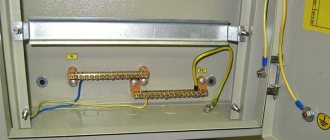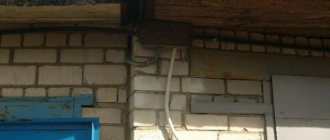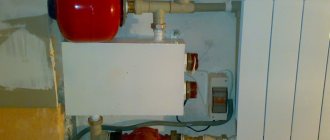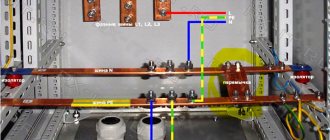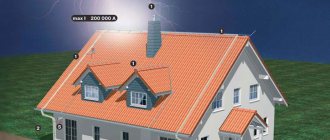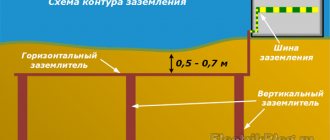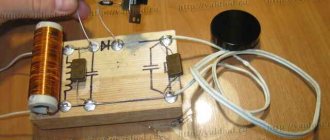Safe operation of electrical appliances is impossible without grounding. This ensures human protection from electric shock and guarantees long-lasting operation of household appliances. In old houses there is no protective grounding, but outdated energy supply systems are being replaced by new ones.
To make grounding in an apartment or private house yourself, you need to figure out what electrical system is present there and what is needed to connect it to the ground loop.
The right decisions
Method No. 1 - Connecting an RCD
If there is no grounding in the apartment (not provided by the developer), and you still want to protect yourself from electric shock, then it is best to temporarily connect a residual current device (pictured below). This device, of course, will not solve the whole problem, but still, in case of current leakage, it will instantly turn off the power to the device being serviced - a washing machine, water heater or a group of sockets.
In addition, we recommend that you replace the electrical wiring in the apartment yourself with a new one - with a three-wire wire. In the future, when the time comes to do grounding in your entrance, you will already be prepared, and all that remains is to conduct and connect the PE wire to the corresponding bus of the floor panel.
Method No. 2 - Installation of your own circuit
There have been recent cases when residents of panel houses decide to make their own grounding in a Khrushchev-era building, for which they organize an individual grounding circuit. This idea is that a single-core PE wire is pulled from the apartment to the basement along risers. At least three metal corners or electrodes connected to each other by a metal plate are driven in near the house. A wire drawn from the floor is connected to the finished protective triangle (shown in the diagram below), the other end of which is fixed to the panel body. All that remains is to connect the grounding of the apartment to the shield and, as you understand, the leakage protection is ready!
We draw your attention to the fact that you can do such grounding yourself only after coordinating this activity with the management company. Spontaneously making this decision can lead to many problems, because... You, no matter how, interfere with the approved project, and if some kind of accident occurs, it is possible that you will be the last one.
I would also like to add that if you decide to make your own grounding loop in the apartment, then the PE wire must be copper, with a cross-section of at least 4 mm2. This method of protection is suitable not only for residents of the first floor, but also for everyone else - the 4th or even the 5th.
Video review of the protective system:
Electrical wiring grounding technology
RCD installation
There are several options that can partially solve the issue of grounding in an apartment. One of them is the installation of a residual current device, or RCD in short. It does not solve the entire problem, but it will turn off the power supply in the apartment if there are electrical leaks in it.
Here is a diagram for connecting an RCD without grounding. Let’s immediately make a reservation that this device can only be installed in TN-C systems, because in other circuits it has nothing to do, grounding works. In addition, the RCD itself has only two contacts, where there is no third one, designed for a grounding conductor. In fact, this device is a kind of switch that not only reacts to leakage currents, but also controls their magnitude. If the value is small, then the device does not turn off the power supply. As soon as the current value exceeds the permissible value, the network is immediately switched off.
How to connect an RCD in a panel? It is installed between the input switch and the circuit breakers.
Attention! If the apartment uses household appliances with a power of more than 1.2 kW, then it is recommended to install a separate power circuit for each of them, and install a separate circuit breaker and RCD in the panel.
Now the connection diagram:
- The device has two input terminals and two output terminals. The connection to the input phase terminal is made from a general circuit breaker. To zero from zero of the switchboard housing.
- The output phase terminal of the RCD is connected to the input contacts of the machine. The output zero is connected to a special connecting device, which is installed on the mounting rail of the machines.
Now you need to check how the protective device works. Turn on the general machine and the intermediate one, turn on the RCD. All that remains is to connect some household appliance under load to the outlet. If the protective device does not knock out, then everything is done correctly.
There is a “TEST” button on the device. It is specially installed to test the device before connecting it to the power network. Turn on the general circuit breaker, but do not turn on the intermediate circuit breakers. You press the button. If the RCD device turns off, then it is working.
How to ground in an apartment with your own hands?
The easiest way to ground sockets in an apartment is for residents of the first floors. In this case, they can simply lead the ground wire into the yard.
Residents of other floors need to connect the grounding wire to the panel and bring it to the ground panel. After this, a wiring of three wires is pulled to the desired location. This is a very economical and simple method, but it is only possible if you are currently undergoing repairs. In other cases, for example, when purchasing new household appliances, grounding is also necessary, but it cannot be done this way. True, you can plug the equipment directly into an outlet, but there is a risk of getting an electric shock when working with it.
DIY grounding devices: diagrams and examples
As an example, let’s take the successful experience of a grounding device, carried out on the basis of an officially certified project, tested and approved for operation.
For a grounding device it is necessary:
Machine and welding helmet. Two shovels (scoop and bayonet). Hammer or sledgehammer. Steel angles. Steel rod. Wires. Electrodes. Corrugated pipe. Terminal.
For example, let's take a private house.
We mark the points at a distance of 1.5 meters from each other, hammer in 3 steel corners. between which we hammer in electrodes at a distance of 1.5 meters - 3 steel, 3-meter corners. The corners are driven in vertically, recessed to 50%! g (MISSING) of the depth of the dug ditch (about 50 cm from ground level). The ditch is dug in the shape of a triangle.
The corners are welded to electrodes driven into the ground, all planes are properly welded with a welding machine. After this, it is necessary to measure the grounding resistance.
Note! The maximum permissible resistance level is 30 ohms.
After checking the resistance, we proceed to weld the metal rod to the corner of the ground loop. The rod is laid to the house. After this, it needs to be lifted under the pediment and connected to the shield.
Using bolts, we connect it to the panel body and distribute it among electrical appliances and sockets, and fill the excavated soil into the ditch.
Let's look at another example.
To set up this system you will need:
grounding stakes; metal jumpers for combining stakes; transmission lines from the circuit to the shield.
The diagram shows the most popular grounding model:
4
Grounding for a group of outlets
At the moment, manufacturers have already produced a large number of affordable European and American sockets. But in the CIS and Europe, the most common is the European type. They have a “phase”, “zero”, as well as a grounding contact that protrudes from the housing by 4-5 mm.
In fact, diverting electricity from outlets is a very important step, without which no existing premises can do. For strong and reliable protection of sockets, you will need a screwdriver, electrical tape, pliers and a special cable that must be connected to the grounding contact on the reverse side.
We recommend: How much gas will fit in a 50-liter cylinder - detailed calculation
European-type sockets have a grounding contact that protrudes from the body by 4-5 mm
It is the connection of the cable to the contact that makes the outlet grounded and absolutely safe for all residents. This is a very easy job that absolutely anyone can handle. You just need to study a few manuals or learn more from a specialist.
But it is strongly recommended to delegate the work to a specially trained person who can reliably and safely ground the outlets in your apartment. After all, manual intervention in the electrical system may not end entirely favorably.
Potential equalization system
A potential equalization system is necessary to increase the efficiency of grounding in an apartment. Typically, only an additional potential equalization system is used for apartments - increasing electrical safety in wet rooms.
Potential equalization system (EPS)
To install the control system, you need a potential equalization box and conductors that will connect the control system to the bus on the input-metering device and to all metal elements in the room that may be energized. The conductor material is copper.
The last stage of installing a potential equalization system is checking the quality of connections and carrying out electrical measurements.
Assembling your own circuit
There is another option that is suitable for residents of the first floors of an apartment building. It fully answers the question of how to make grounding in an apartment. This grounding scheme for an apartment is based on creating your own grounding wire. What needs to be done?
- First, you need to drive three metal pins into the ground on the street. They can be made from rebar by sharpening the ends. The diameter of the pins is 8-12 mm.
- The location of the pins relative to each other is a triangle with sides of 1.0-1.5 m. It is necessary to drive it to a depth of 2-3 m so that the end of the reinforcement protrudes from the surface of the ground by 3-5 cm.
- All pins are tied together with metal tape 2-3 mm thick and 20-30 mm wide. The strapping method is welding.
- This structure is connected to a distribution board or metal strip or cable with a cross-section of at least 5 mm².
Content
Grounding for a new building How to ground in an old house? Reasons that exclude the installation of grounding Video about grounding and grounding in detail
Before starting work, you need to find out which system is used in your home. According to the rules that were adopted back in 2003, each building must be equipped with a riser of five wires, in which the 5th wire is precisely the grounding conductor. If everything is exactly like this in your house, then all you have to do is distribute the grounding wire throughout the apartment (the third core in the cable), then install special sockets with grounding everywhere, and arrange a DSUP in the bathroom.
1. So, in new (post-Soviet) houses, this is, as a rule, a modern TN-C-S system (it has zero both working and protective conductors, which are usually connected in the main panel of the building; then they are disconnected everywhere). In this system, 3 phases L, as well as a separated N (working neutral) and PE (protective conductor) are suitable for the access risers. The connection process is much simpler, since the floor panel already has separate buses designed for connecting zero, phase and grounding. And the grounding bus has a metal connection with the electrical panel housing.
Apartment power supply TN-CS
It is not difficult to determine whether your home is connected by (TN – C – S). Just look at the cable that goes to the riser (input). It should have 5 wires:
3 phases such as L1, L2, L3; protective zero PE; working zero N.
The connection is made as follows:
the phase wire from the apartment is connected to the same bus where the previous old wire was; the working neutral N wire is connected to the bus with neutral wires; The PE grounding wire (neutral protective) is connected to the panel body.
Important! You cannot connect all the grounding wires (which are in the panel) to 1 bolt (clamp)! It is necessary to use different bolted connections. It is better to use a busbar: screw it to the shield, then connect the PE.
An example of separation by household appliances: lighting devices, power supplies, large household appliances are grounded separately
It is also important to consider the following:
with a 3-phase input, absolutely all conductors must have the same cross-section (for copper up to 16 mm2); under 1 terminal of the machine you can clamp up to 2 conductors of the 1st section; to obtain a uniform load, a 3-phase connection to the hob would be preferable; all metal parts in the bathroom (pipes, heated floor screen, bathtub, etc.) and the grounding conductor of the socket (of course, if there is one in the bathroom) must be connected to the DSUP (or KUP) bus, which must be located there. In this case, the socket is powered using a 3-wire circuit; all PE conductors with mechanical protection should have a cross-section of 2.5 mm2, if not, 4 mm2. The conductor from the DSUP bus to the PE panel bus (preferably a floor one) should have a cross-section of 6 mm2; It is preferable to separate lighting and power (socket) circuits. However, mixed power supply is allowed. And the lines to all power units (stove, oven, CM) must be separate.
2. In some new type of apartment buildings (since 1997) TN-S is used throughout the entire length of the building. This grounding is the most reliable. When connecting a house, the grounding wire is laid separately, together with the phase and neutral wires from the substation to the electrical panels of the house. The work is carried out in the same way as in TN – C – S.
Visual representation of TN-S: output of each element, including the neutral cable, to a separate grounding bus
In old houses, a TN-C system is usually found, in which throughout its entire length the neutral conductors (working and protective) are combined into one neutral conductor (PEN). We connect the body of the electrical equipment (electrical device, panel body or assembly) to the PEN conductor. Such protection is called nullification. The grounding circuit is installed at the substation that supplies the house. 3 phases L, as well as a combined PEN conductor, are suitable for the access risers. All floor panels in such a system are grounded, and grounding is not provided for them.
We recommend: Construction and installation of radiators in the floor, radiators, convectors - we study thoroughly
TN-C grounding system
Electrical wiring in the case of single-phase power supply to the living space is carried out with 2-core cables (phase, PEN). Or 4-core cables (A, B, C, PEN) with 3-phase power supply to the apartment. There are no protective grounding contacts in the sockets.
This is the oldest and most common system. It existed in the USSR for a very long time and, unfortunately, still continues to exist in many homes. There is a serious risk of electric shock when used. Automatic switches (protective switching devices) installed with the TN-C system protect electricity. circuits (groups, lines) only from short circuit currents. But protection against electric shock is completely absent.
Important! If an electrician recommends electrical installation using TN-C, do not hesitate to refuse! It is completely unable to protect against electric shock! The operation of electrical appliances with such a system poses a potential threat to life! In addition, the PUE (clause 1.7.80) prohibits installing an RCD in this grounding system as the main protection.
According to new standards adopted in 2003, in all old houses the TN-C system must be converted to either a TN-CS or TN-S system by upgrading the power supply circuits (installation of a potential equalization system). However, poor financing does not yet allow this to be implemented in all houses. In most cases, energy supply organizations proceed as follows: at the entrance to an apartment building, they re-ground the neutral wire. Then divide the PEN conductor into 2 separate wires:
zero (N) working conductor; protective (PE) conductor.
Important! If you have a TN-C system, unfortunately, you can’t do anything on your own regarding grounding! You cannot build your own personal storage unit! Since it will be located outside the EMS of the house and can cause the appearance of stray currents. Therefore, you can only use the existing common house system.
In other words, you need to either completely re-equip the entire wiring of the house to new standards, or use electrical appliances with a body made of non-conductive material. It is also recommended to install an RCD on the circuits that power household appliances. This is especially important in the bathroom. An RCD is not capable of protecting against electric shock, but it will save you from fatal shock.
If the grounding is not connected to water pipes, batteries, fittings and other conductive parts of the apartment, then dangerous voltage will appear between the equipment connected to such wiring and these parts. But even if you connect and the grounding turns out to be good, then from these structures the equalizing current through the grounding will flow through the entire apartment. Such currents can be very large, so if the PEN (main ground electrode) is broken, there will be a fire hazard due to excess currents. But that is not all. If voltage occurs on the housing of electrical appliances, grounded by a battery or water pipe, all pipes and batteries will come under voltage, including those in neighboring apartments. As a result, the neighbor who decided to pour water from the tap could be electrocuted to death! The ban on the use of pipes is written in VPUE 1.7.110. It is also impossible to simulate the circuit through a connection in a Euro socket of a “zero working” with a “zero protective” conductor. This is extremely dangerous. There are frequent cases of burnout of the “zero working” conductor in the shield. And this leads to the fact that on the case of a computer, refrigerator, etc. 220 V is placed. The only exception is grounding “to zero”, which is done in houses specially equipped for electric stoves. However, this should be done only after carefully examining the neutral conductor for cross-section (at least 16 square meters for aluminum), as well as continuity (according to PUE 7, paragraph 1.7.131). This must be done by a qualified electrician.
Thus, we see that in some cases it is not easy to carry out the circuit in an apartment. If it is a TN – C – S or TN – S system, then you can ground it yourself (that is, run the wires around the apartment). If it is an outdated TN-C, then even an experienced electrician will not help in the case of a separate apartment. It needs to be changed throughout the house.
Expert advice
If your apartment does not have grounding, use the services of a specialized company that will not only carry out the work in accordance with the rules and regulations, but also provide the necessary documents and a guarantee for the work performed.
In older houses with a four-wire riser (3 phases + neutral), only 2 wires should be used. To increase safety, use RCD . If you are repairing electrical wiring in an apartment, lay the wiring with a three-core cable, but do not connect the third protective conductor, grounding, on both sides until better times. Sooner or later, your entrance will be transferred to the TN-CS grounding system, then connect.
For a better understanding of the issue, I recommend watching the video:
Do you have anything to add to the material? LEAVE A COMMENT
Dangerous defense option
Some would-be electricians decide to ground the apartment by simply connecting the third wire to the plumbing or heating system running through the room. Do not use this type of ground loop under any circumstances, because... in this case the picture is as follows:
a breakdown of current occurs on the body of an electrical appliance (boiler or washing machine in the bathroom); dangerous current passes to batteries and hot/cold water risers not only of your apartment, but also of all neighbors, because the system is unified. Anyone who at the moment decides to drink water from the tap or simply touch metal pipes can become a victim.
By the way, the rules of the PUE stipulate this point and are also strictly prohibited, according to PUE 1.7.110.
In addition to this method of grounding an apartment, the following are also considered unsafe:
Connection in the socket of a neutral with a grounding conductor (the so-called grounding). If the neutral wire in the network suddenly breaks, dangerous voltage will transfer to the housing of all electrical appliances connected to the grounding of the apartment - computer, water heater, refrigerator, etc. Sequential grounding of electrical appliances (through each other). If you decide to make such a grounding loop, be aware that if an accident occurs, electromagnetic incompatibility may occur. As a result, electrical installations will create interference and there is a high likelihood that the ground loop will not prevent electric shock. Connecting several wires to one PE bus terminal. One conductor can be connected to each contact pad. Neglecting this rule is strictly prohibited.
We recommend: Possible connection diagrams for heating radiators
Consideration of the issue by a specialist
That's all you need to know about how to make grounding in an apartment if there is none. We still strongly recommend using an RCD as a temporary protection option, and insist that the city authorities take care of upgrading the electrical wiring in your home.
Related materials:
There is an electric current in the bathroom - what to do How to connect a voltage control relay Proper grounding in a private house
Example of the need for grounding
Grounding a bathtub in an apartment
Grounding the electrical wiring is necessary to prevent shock from capacitive current resulting from voltage leakage through the branch of the LC filter, the middle of which is connected to the body of the device. Such filtering devices are used, for example, in some models of washing machines. When connecting the washing machine to an ungrounded socket, the potential difference between the surface of the device and the person next door will be equal to the input voltage divided by 2. The described case is also fraught with the possibility of false triggering of the RCD.
If you grab zero with one hand and the phase with the other, the body will become a conductor between different potentials
Another example is preventing the consequences of electromagnetic incompatibility of devices connected to the network. If the zero working cable breaks, then all devices connected to the network fail. Grounding is also important to protect electronic computing devices from electrical discharge emanating from the human body. It has low power, but sometimes it is enough for the device to fail or begin to freeze. The grounding system equalizes the potentials, thereby preventing a situation where, when the heating pipe and the computer's operating panel touch simultaneously, the latter begins to malfunction due to an electrical discharge.
Types of grounding in an apartment
In all new buildings, the problem of grounding is solved already when the house is put into operation, however, in old apartments you often have to do it yourself.
You can create protection only by knowing where which wire needs to be connected. Houses built at different times use different grounding systems.
If there is no grounding in the apartment, you need to do it yourself, but you should be very careful, since improperly performed work can lead to a power failure or even a fire.
The following types are known:
TN-S. TN-S. TN-C-S. TT. IT.
These systems differ in that some of them have a “ground” wire, and some have only “phase” and “zero”. You can understand whether there is such a wire by the second part of the system marking - in a system with the letter S, zero and ground are in different wires, and with the letter C - in one. The letter N indicates the neutral, which is used in alternating current networks.
Grounding in old apartments is usually done using the TN-C system. Houses built before 1998 typically have two-wire wiring, with aluminum and copper wire. More modern houses usually use the TN-S or TN-C-S system.
To determine the type of protection system in your home, you need to contact the housing office, where electricians will answer this question for you.
What is not recommended to do
It is forbidden to use water and gas pipes as grounding conductors.
Sometimes apartment owners, in order to save money, try to use “non-standard” options for organizing grounding - for example, a jumper between zero and the protective conductor, screwing in protection only for their apartment, using heating or gas pipes as grounding conductors. Doing this is strictly prohibited.
Local network intervention using “quick fixes” does not protect against emergency situations; moreover, its organizer will not be able to present a material risk due to the lack of an official right to make upgrades to the existing system. Using pipelines as grounding can result in the death of a resident or the destruction of a building.
Before organizing a grounding system, you should consult with the workers servicing the house regarding the preferred system option. Unauthorized actions can cause serious harm to the inhabitants of the apartment.
Types of grounding for a private house
There are 6 types of grounding systems for private houses, but two systems are the most popular in construction: TN-SC and TT, with TN-SC being the most recommended for individual development.
The grounding device has contact with the ground, and the neutral is solidly grounded. Thanks to this, the earth and neutral go to the residents of the house through a single conductor, and before entering the house they are divided into two separate ones.
With the TN-CS system, RCDs are not required - automatic machines are installed on it. But the popular system also has its drawbacks: if the wire is damaged, phase voltage may appear, and it is not possible to turn it off. Therefore, these lines must have wire protection and backup grounding every 100-200 meters.
However, the older the power lines, the more often they do not meet the above requirements. This situation can be observed especially often in villages. In this case, the TT system is suitable.
The TN-CS TT system differs in that the grounding wire to the switchboard does not come from the transformer, but from the grounding loop. The TT system is resistant to damage to the wire, but it has its own drawback: the mandatory installation of an RCD.
The TT system is considered a backup and can only be used if the power line does not meet TN-SC requirements.
2
Residual current device
An RCD is a device that is especially in demand when there is no electrical outlet in a residential building at all. That is, the development company that built the house did not provide for the possibility of grounding the current. This device will help you avoid contact with electricity, but it will not be able to fully protect you from injury.
To connect, you will need to arm yourself with a set of screwdrivers, pliers, electrical tape and, in fact, the device itself. First of all, take care of changing the general wiring - three-wire wiring is best. It is an order of magnitude more reliable and safer, even when many different devices with different powers are connected to the network.
Some household appliances can be grounded using an RCD
By replacing the wiring and installing an RCD device, you will be completely ready to connect to the general network, which will soon be connected to your entrance. And then all that remains is to connect the three-wire wire to the floor panel.
This device will not be able to successfully and safely ground all household appliances. The maximum he can do is a washing machine, a boiler that heats the water and a couple more sockets. Therefore, you will need to take care of a more reliable and powerful method.
